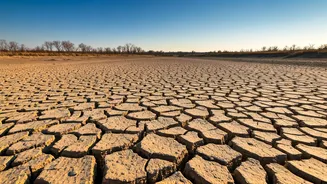The Ground's Secrets
The seemingly solid earth beneath our feet is a complex interplay of various materials and formations, each exhibiting unique reactions to the powerful
forces unleashed by earthquakes. The concept of 'stable ground' isn't as simple as it sounds. Certain ground conditions amplify seismic waves, turning a moderate earthquake into a destructive event. For example, loose, water-saturated soils can act like quicksand during an earthquake. This process, known as liquefaction, causes the ground to lose its strength, making it incapable of supporting structures. Buildings can sink, tilt, or even collapse entirely. Similarly, the type of bedrock, the presence of faults, and the underlying geological structures also play significant roles. Areas built on hard bedrock may experience less intense shaking than those built on softer sediments. Understanding these intricacies is critical for assessing seismic risk and designing structures that can withstand earthquakes. It’s a multi-faceted interplay between the ground’s composition and the behavior of seismic waves.
Soil's Vulnerable Role
One of the most significant factors influencing earthquake impact is the type of soil present. Different soil compositions respond differently to seismic waves. Consider loose, unconsolidated sediments like sand and silt. These materials are particularly susceptible to liquefaction, a phenomenon in which the ground loses its structural integrity and behaves like a liquid. During an earthquake, the shaking can cause the water-saturated soil particles to separate and lose their friction, resulting in the ground’s inability to support the weight of buildings. This can lead to catastrophic failures, including building sinking, tilting, or even complete collapse. Conversely, bedrock, a solid and dense material, tends to transmit seismic waves more efficiently, often resulting in less amplified shaking. The contrast underscores the importance of conducting thorough soil analysis before any construction project in earthquake-prone areas. These studies help engineers understand the soil's behavior under seismic stress, allowing them to design foundations and structures to mitigate potential damage.
Water's Amplifying Effect
Water saturation dramatically influences soil's response to earthquakes. When the ground is saturated with water, particularly in loose, granular soils, the risk of liquefaction significantly increases. The water fills the spaces between soil particles, preventing them from compacting and increasing the pore water pressure. Under the stress of an earthquake, this pressure rises rapidly. It separates the soil particles, causing the soil to behave like a liquid. Buildings that are on saturated ground face a higher risk of sinking, tilting, or collapsing because the soil loses its ability to support them. In coastal areas or near bodies of water, where the water table is high, the risk of liquefaction is particularly elevated. Even in areas that might seem stable, the water content within the soil can turn them into hazardous zones during an earthquake. Therefore, careful consideration of groundwater conditions is essential when assessing seismic hazards and designing earthquake-resistant structures.
Geology's Hidden Hand
The underlying geological formations profoundly impact how an earthquake's energy propagates and affects the surface. Fault lines, where the earth's crust fractures, are obvious areas of seismic activity. But even distant geological structures can influence the intensity and duration of shaking. For instance, the presence of sedimentary basins, which are geological depressions filled with layers of sediment, can amplify seismic waves. The soft sediments in these basins can trap and resonate the energy, prolonging shaking and causing more damage. Moreover, the type of bedrock beneath the surface also has a critical role. Harder bedrock transmits seismic waves more efficiently, often resulting in less amplified shaking, as opposed to softer bedrock, which can amplify the waves. Understanding the local geology, including the presence of faults, basin structures, and soil types, is thus critical in assessing earthquake risk. This information helps engineers and city planners make informed decisions regarding building codes, land use, and emergency preparedness.
Building for Safety
Building design and construction methods can significantly mitigate earthquake risks. When building in seismically active areas, it's essential to consider the soil conditions, geological features, and potential for liquefaction. Foundations must be designed to withstand the forces generated by seismic activity, often involving techniques like deep foundations, ground improvement, and base isolation. Deep foundations, such as piles or caissons, can transfer the building's weight to more stable layers of soil or bedrock, bypassing the unstable surface layers. Ground improvement techniques, such as soil compaction or soil stabilization, can increase the soil's density and strength, reducing the risk of liquefaction. Base isolation involves separating the building from the ground using flexible bearings, which absorb seismic energy and reduce the amount of shaking that reaches the structure. Adherence to strict building codes that address seismic design is crucial. These codes specify the required materials, construction techniques, and structural elements needed to ensure that buildings can withstand earthquakes. Regularly inspecting and maintaining buildings are also vital to ensure their continued safety and resilience.
Beyond Buildings: Preparedness
Preparedness extends beyond structural measures. Educating the public about earthquake risks, providing them with training on what to do during an earthquake, and establishing effective emergency response plans are crucial. Public awareness campaigns can educate people about the hazards in their region, what to do before, during, and after an earthquake. This includes securing heavy objects, preparing emergency kits, and knowing how to shut off utilities. Emergency response plans should outline the steps that will be taken after an earthquake, including search and rescue operations, medical assistance, and the provision of essential services. Regular drills and exercises help people practice these steps and improve coordination among emergency responders. Developing and maintaining early warning systems can provide valuable seconds of warning before an earthquake. These warnings can allow people to take protective actions, such as taking cover or shutting down critical infrastructure, reducing the risk of injury and damage. Community involvement and participation in these activities are crucial for building resilience and mitigating the impact of earthquakes.











